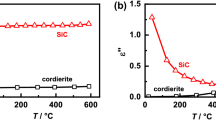Abstract
Three-way catalyst-based automotive exhaust gas aftertreatment is of high importance to meet today’s emission standards. To determine in situ the oxygen loading state of three-way catalysts, a microwave cavity perturbation method is used. In this study, it is investigated whether this measurement setup that had originally been described for full-sized catalysts can be transferred to a lab test bench using cores of 1″ diameter. The initial tests were successful and a high correlation between the oxygen loading degree dependent resonance frequency and the conversion was found. As an application example of the new in situ characterization technique, the steady state degree of oxidation of a three way catalyst was measured as a function of the exhaust stoichiometry. The experimental results are compared with the prediction of a recently published improved kinetic model that takes into account the oxidation of reduced ceria by H2O and CO2. It is shown that the experimental observations agree very well with this improved model. This result provides evidence that under typical operating conditions, the degree of oxidation of the three way catalyst is controlled by equilibrium effects.





Similar content being viewed by others
References
Moos R, Spörl M, Hagen G, Gollwitzer A, Wedemann M, Fischerauer G (2008) TWC: lambda control and OBD without lambda probe—an initial approach. SAE Paper 2008-01-09196. doi:10.4271/2008-01-0916
Moos R, Wedemann M, Spörl M, Reiß S, Fischerauer G (2009) Direct catalyst monitoring by electrical means: an overview on promising novel principles. Top Catal 52:2035–2040
Reiß S, Spörl M, Hagen G, Fischerauer G, Moos R (2011) Combination of wirebound and microwave measurements for in situ characterization of automotive three-way catalysts. IEEE Sens J 11:434–438
Fischerauer G, Spörl M, Reiß S, Moos R (2010) Mikrowellengestützte Aufklärung elektrochemischer Vorgänge in Katalysatoren und verwandten Systemen. Tech Mess 77:419–427
Reiß S, Wedemann M, Spörl M, Fischerauer G, Moos R (2011) Effects of H2O, CO2, CO, and flow rates on the RF-based monitoring of three-way catalysts. Sens Lett 9:316–320
Fischerauer G, Spörl M, Gollwitzer A, Wedemann M, Moos R (2008) Catalyst state observation via the perturbation of a microwave cavity resonator. Frequenz 62:180–184
Fischerauer G, Gollwitzer A, Nerowski A, Spörl M, Reiß S, Moos R (2011), Monitoring of Electrochemical Processes in Catalysts by Microwave Methods. In: S. Lindenmeier, R. Weigel (eds.), Electromagnetics and Network Theory and their Microwave Technology Applications, Springer, Berlin p. 119-132, ISBN: 978-3-642-18374-4. doi:10.1007/978-3-642-18375-1_9
Izu N, Oh-hori N, Shin W, Matsubara I, Murayama N, Itou M (2009) Response properties of resistive oxygen sensors using Ce1−x ZrxO2 (x = 0.05, 0.10) thick films in propane combustion gas. Sens Actuators B 130:105–109
Moos R (2010) Catalysts as sensors—a promising novel approach in automotive exhaust gas aftertreatment. Sensors 10:6773–6787
Chatterjee D, Deutschmann O, Warnatz J (2001) Detailed surface reaction mechanism in a three-way catalyst. Faraday Discuss 119:371–384
Möller R, Votsmeier M, Onder C, Guzzella L, Gieshoff J (2009) Is oxygen storage in three-way catalysts an equilibrium controlled process? Appl Catal B 91:30–38
Jungkunz T, Fischerauer G (2012) Modellgestützte Bestimmung der komplexen Permittivität heterogener Katalysatoren im instationären Fall, 16. GMA/ITG-Fachtagung Sensoren und Messsysteme, 22–23.5.2012, Nürnberg, Germany. doi:10.5162/sensoren2012/6.2.3
Moos R, Beulertz G, Reiß S, Hagen G, Fischerauer G, Votsmeier M, Gieshoff J, Overview: Status of the microwave-based automotive catalyst state diagnosis. Top Catal (accepted). doi:10.1007/s11244-013-9980-x
Acknowledgments
The authors R.M. and G.F. gratefully acknowledge DFG grants MO 1060/13-1 and FI 956/5-1, respectively.
Author information
Authors and Affiliations
Corresponding author
Rights and permissions
About this article
Cite this article
Beulertz, G., Fritsch, M., Fischerauer, G. et al. Microwave Cavity Perturbation as a Tool for Laboratory In Situ Measurement of the Oxidation State of Three Way Catalysts. Top Catal 56, 405–409 (2013). https://doi.org/10.1007/s11244-013-9987-3
Published:
Issue Date:
DOI: https://doi.org/10.1007/s11244-013-9987-3




